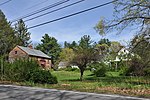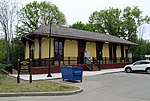Job Lane House

The Job Lane House is a historic house at 295 North Road in Bedford, Massachusetts. It is a 2+1⁄2-story wood-frame structure, with a side-gable roof, clapboard siding, and a stone foundation. A leanto section to the rear gives the house a saltbox profile. The house was built c. 1713 by Job Lane, one of Bedford's earliest settlers, on land acquired by his grandfather (also Job Lane) in 1664 from Governor John Winthrop.The house was added to the National Register of Historic Places in 1973. It is owned by the Town of Bedford and operated as an 18th-century historic house museum. There are a number of planned activities that take place on the site each summer. Information on these, and other possible uses of the property, as well as considerable interesting historical and genealogical facts about the builder and subsequent owners, can be found on the site's web page: https://joblanefarmmuseum.org.
Excerpt from the Wikipedia article Job Lane House (License: CC BY-SA 3.0, Authors, Images).Job Lane House
North Road,
Geographical coordinates (GPS) Address Website Nearby Places Show on map
Geographical coordinates (GPS)
| Latitude | Longitude |
|---|---|
| N 42.512777777778 ° | E -71.284444444444 ° |
Address
Job Lane Farm Museum
North Road
01730
Massachusetts, United States
Open on Google Maps









